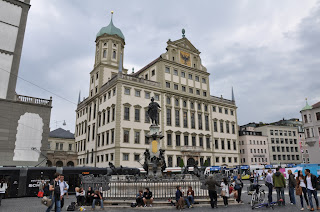On day two of our road trip, we decided to follow the Romantische Strasse ("Romantic Road") north from Füssen and stop in some small towns along the way. The road was originally a medieval trade route that linked important towns at the time, though its name wasn't coined until the1950s when travel agents looking to boost tourism. Apparently the route is very popular with Japanese tourists, in particular, as all the signs are in Japanese as well (see below).
The first town that we visited was Dinkelsbühl, which was founded in the 11th century and whose look is considered representative of a typical German town in the 15th - 17th centuries. The town is also notable in that it was a "mixed imperial city" during the reformation -- i.e., it had a joint Catholic-Protestant government with an equal distribution of Catholic and Protestant civic officials.
The city's medieval wall and towers were very well preserved, in part because Dinkelsbühl made it through WWII virtually unscathed.
Many of the towers were ultimately converted into small homes (or perhaps apartments is a better description), which we were a bit surprised by. It would have been really interesting to tour a few of the towers to see what the interiors were like, but that unfortunately wasn't in the cards.
We spent the majority of our time in Dinkelsbühl simply wandering the streets of the old town and taking in the main sights. I particularly liked the general architecture of the buildings -- basically a lot of angular, A-shaped rooves with interesting exterior designs.
The city's medieval wall and towers were very well preserved, in part because Dinkelsbühl made it through WWII virtually unscathed.
Many of the towers were ultimately converted into small homes (or perhaps apartments is a better description), which we were a bit surprised by. It would have been really interesting to tour a few of the towers to see what the interiors were like, but that unfortunately wasn't in the cards.
We spent the majority of our time in Dinkelsbühl simply wandering the streets of the old town and taking in the main sights. I particularly liked the general architecture of the buildings -- basically a lot of angular, A-shaped rooves with interesting exterior designs.
Our second stop of the day was Nordlingen, another medieval town along the Romantic Road. Like Dinkelsbühl, the town's external wall remains completely in tact and you have to pass through a gate to enter. The town is a little older, though -- it celebrated its 1100th anniversary in 1998.
As with our visit to Dinkelsbühl, we spent most of our time simply walking around the city and enjoying the sights. As seen in the photo below, the buildings in Nordlingen were also characterized by A-shaped rooves and interesting designs in the walls.
We later learned that Nordlingen was the town shown during the glass elevator scene at the end of the film Willy Wonka and the Chocolate Factory.
Our final stop of the day was Augsburg, where we would spend the night before heading to Munich for Saturday and Sunday. By this point the weather had deteriorated a bit, but it was still nice enough to walk around for some sightseeing before dinner. Here's a view of the Rathaus (city hall), which is the oldest secular Renaissance building north of the Alps.
Like Dinkelsbühl, Augsburg was a mixed imperial city during the Reformation. This is evidenced by the St. Ulrich's and St. Afra's Abbey, pictured below, which consisted of both a Roman Catholic church and a Protestant (Lutheran) church. Needless to say, the interiors of the two churches were considerably different.
While walking around the city we came across the following building, which had the most colorful exterior walls that we had seen during our visit by far. I'm not sure exactly what the murals depicted, but I presume they had something to do with the city's history or perhaps some religious context.
Before calling it a night we stopped for dinner at a restaurant near our hotel. As a whole it was a rather uneventful (albeit good) meal, except for one thing: I was surprised by how many people were having beer with dinner at a nice restaraunt. Sure Bavaria is known for its beer, but I never expected it to play a central role during dinner (basically replacing wine). Then again, the heartiness of Bavarian cuisine clearly goes better with a nice, cold beer than a fine wine (at least based on my limited experience).









No comments:
Post a Comment